Strategic Management Australia Research 2022
VerifiedAdded on 2022/09/17
|8
|1634
|20
AI Summary
Contribute Materials
Your contribution can guide someone’s learning journey. Share your
documents today.
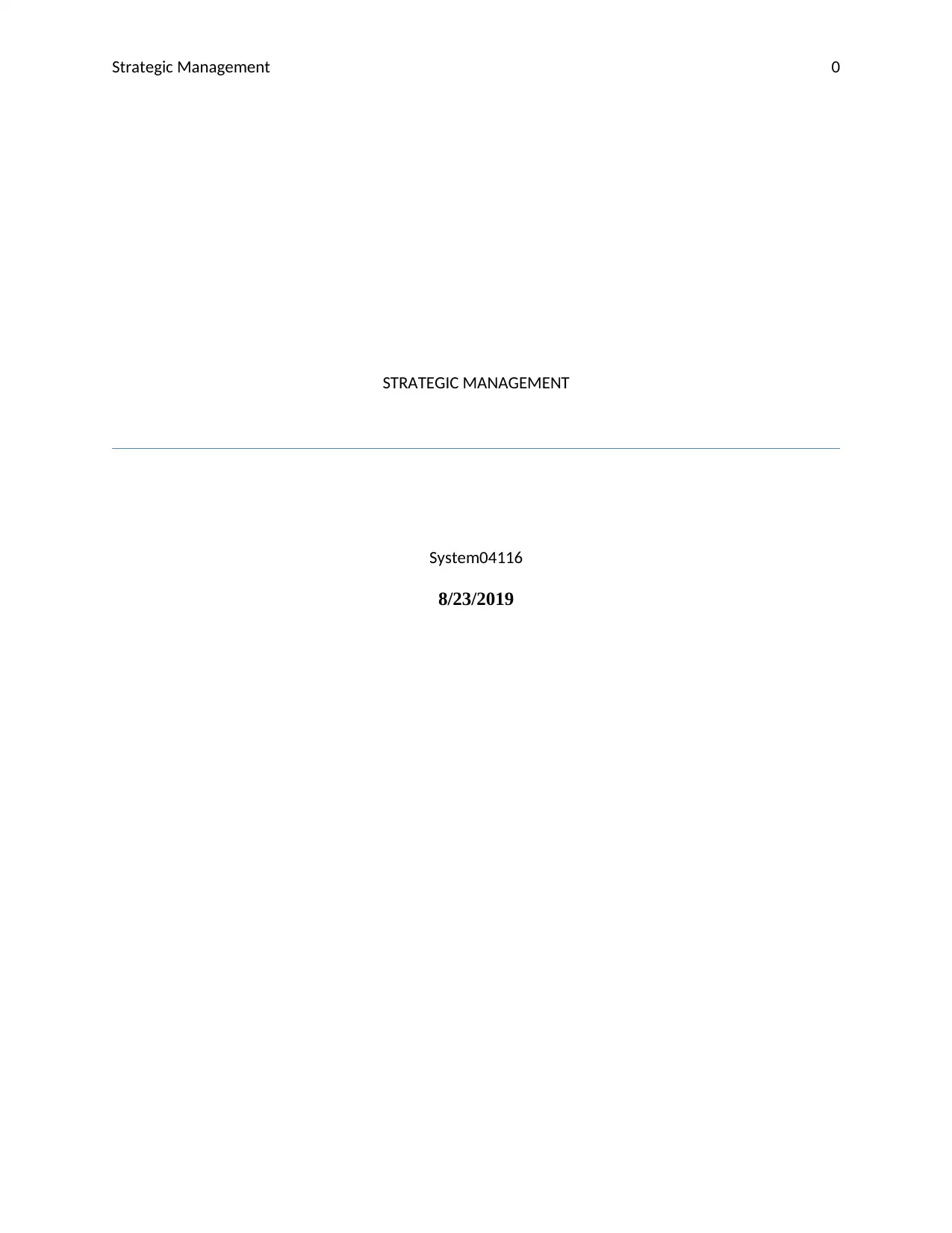
Strategic Management 0
STRATEGIC MANAGEMENT
System04116
8/23/2019
STRATEGIC MANAGEMENT
System04116
8/23/2019
Secure Best Marks with AI Grader
Need help grading? Try our AI Grader for instant feedback on your assignments.
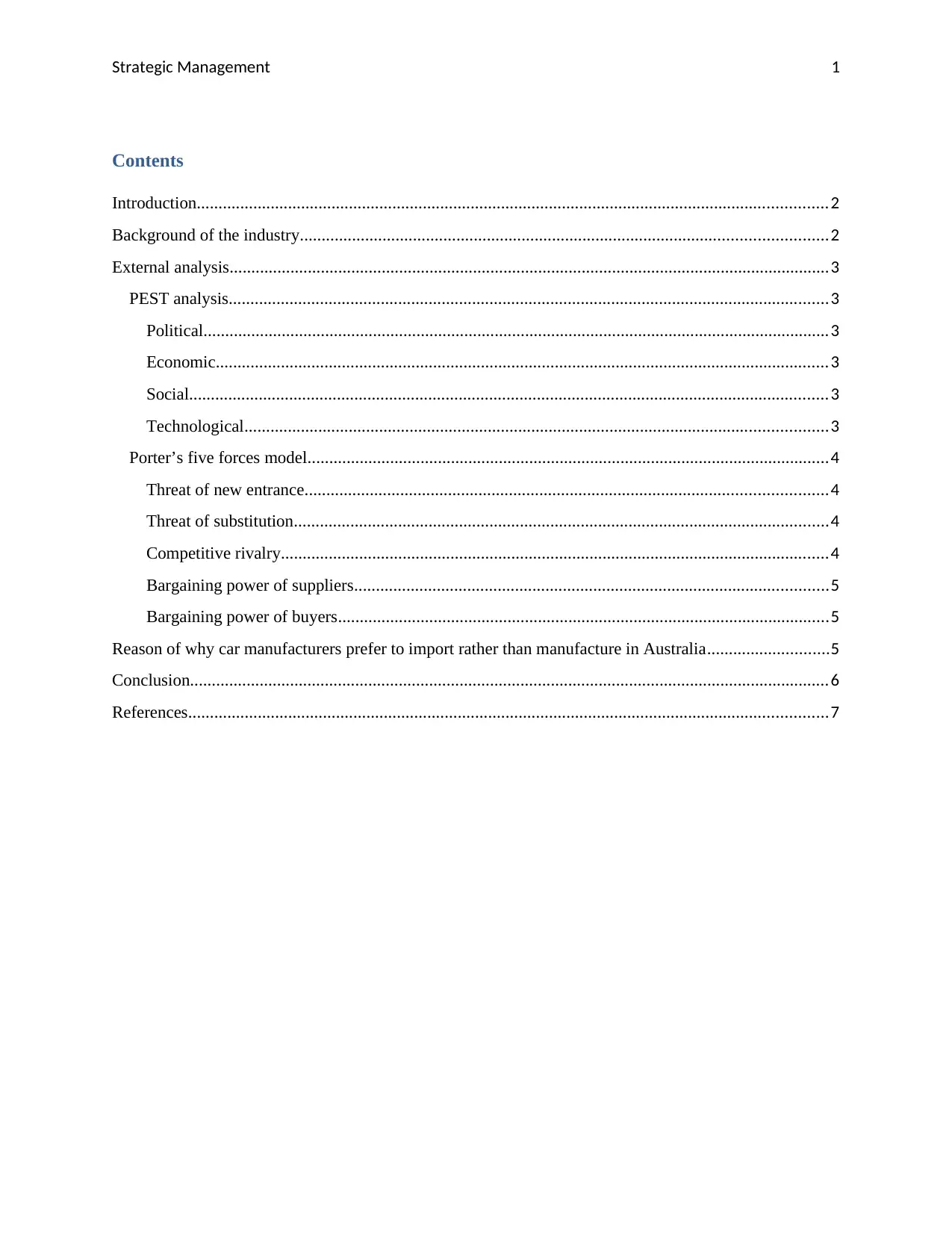
Strategic Management 1
Contents
Introduction.................................................................................................................................................2
Background of the industry.........................................................................................................................2
External analysis..........................................................................................................................................3
PEST analysis..........................................................................................................................................3
Political................................................................................................................................................3
Economic.............................................................................................................................................3
Social...................................................................................................................................................3
Technological......................................................................................................................................3
Porter’s five forces model........................................................................................................................4
Threat of new entrance........................................................................................................................4
Threat of substitution...........................................................................................................................4
Competitive rivalry..............................................................................................................................4
Bargaining power of suppliers.............................................................................................................5
Bargaining power of buyers.................................................................................................................5
Reason of why car manufacturers prefer to import rather than manufacture in Australia............................5
Conclusion...................................................................................................................................................6
References...................................................................................................................................................7
Contents
Introduction.................................................................................................................................................2
Background of the industry.........................................................................................................................2
External analysis..........................................................................................................................................3
PEST analysis..........................................................................................................................................3
Political................................................................................................................................................3
Economic.............................................................................................................................................3
Social...................................................................................................................................................3
Technological......................................................................................................................................3
Porter’s five forces model........................................................................................................................4
Threat of new entrance........................................................................................................................4
Threat of substitution...........................................................................................................................4
Competitive rivalry..............................................................................................................................4
Bargaining power of suppliers.............................................................................................................5
Bargaining power of buyers.................................................................................................................5
Reason of why car manufacturers prefer to import rather than manufacture in Australia............................5
Conclusion...................................................................................................................................................6
References...................................................................................................................................................7
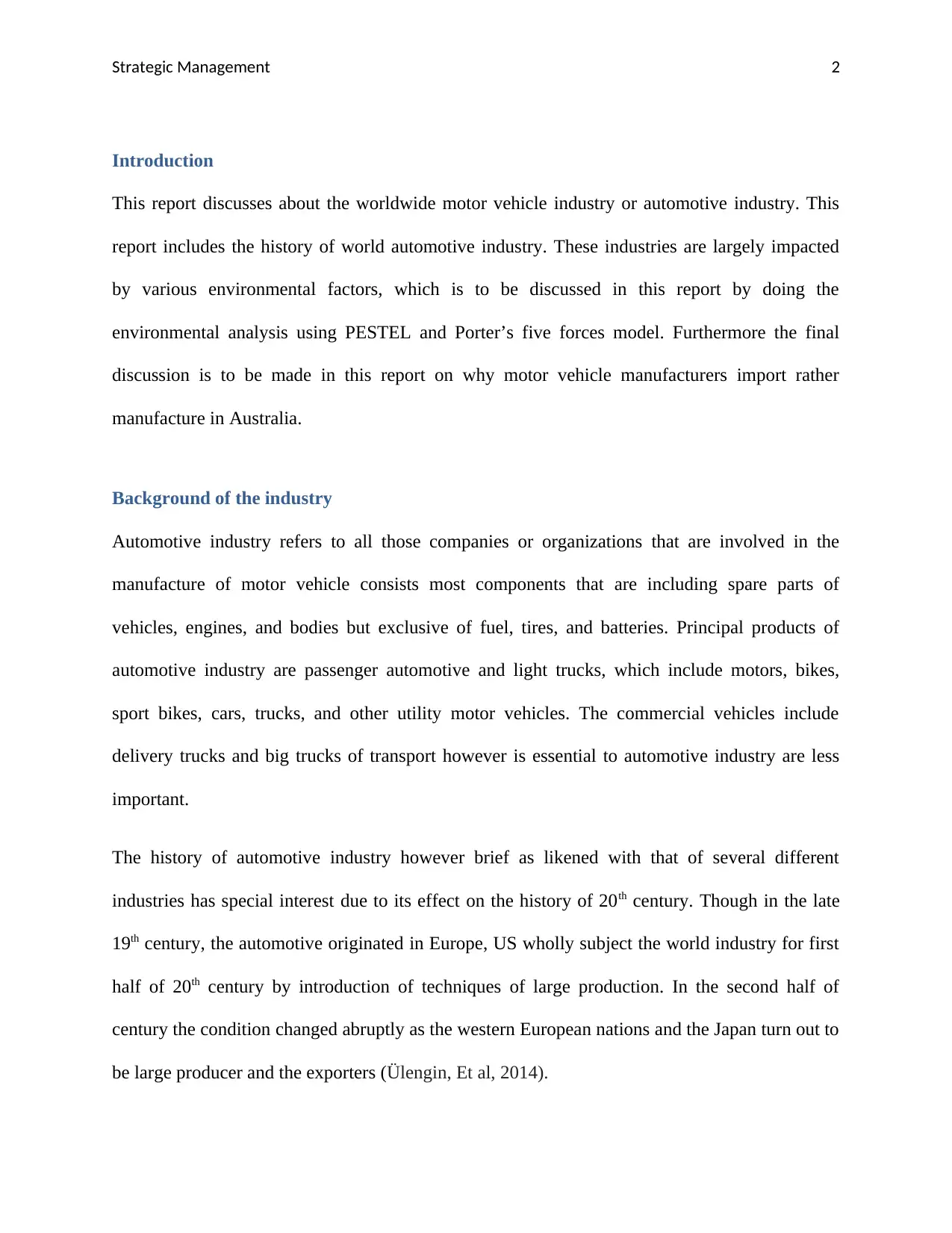
Strategic Management 2
Introduction
This report discusses about the worldwide motor vehicle industry or automotive industry. This
report includes the history of world automotive industry. These industries are largely impacted
by various environmental factors, which is to be discussed in this report by doing the
environmental analysis using PESTEL and Porter’s five forces model. Furthermore the final
discussion is to be made in this report on why motor vehicle manufacturers import rather
manufacture in Australia.
Background of the industry
Automotive industry refers to all those companies or organizations that are involved in the
manufacture of motor vehicle consists most components that are including spare parts of
vehicles, engines, and bodies but exclusive of fuel, tires, and batteries. Principal products of
automotive industry are passenger automotive and light trucks, which include motors, bikes,
sport bikes, cars, trucks, and other utility motor vehicles. The commercial vehicles include
delivery trucks and big trucks of transport however is essential to automotive industry are less
important.
The history of automotive industry however brief as likened with that of several different
industries has special interest due to its effect on the history of 20th century. Though in the late
19th century, the automotive originated in Europe, US wholly subject the world industry for first
half of 20th century by introduction of techniques of large production. In the second half of
century the condition changed abruptly as the western European nations and the Japan turn out to
be large producer and the exporters (Ülengin, Et al, 2014).
Introduction
This report discusses about the worldwide motor vehicle industry or automotive industry. This
report includes the history of world automotive industry. These industries are largely impacted
by various environmental factors, which is to be discussed in this report by doing the
environmental analysis using PESTEL and Porter’s five forces model. Furthermore the final
discussion is to be made in this report on why motor vehicle manufacturers import rather
manufacture in Australia.
Background of the industry
Automotive industry refers to all those companies or organizations that are involved in the
manufacture of motor vehicle consists most components that are including spare parts of
vehicles, engines, and bodies but exclusive of fuel, tires, and batteries. Principal products of
automotive industry are passenger automotive and light trucks, which include motors, bikes,
sport bikes, cars, trucks, and other utility motor vehicles. The commercial vehicles include
delivery trucks and big trucks of transport however is essential to automotive industry are less
important.
The history of automotive industry however brief as likened with that of several different
industries has special interest due to its effect on the history of 20th century. Though in the late
19th century, the automotive originated in Europe, US wholly subject the world industry for first
half of 20th century by introduction of techniques of large production. In the second half of
century the condition changed abruptly as the western European nations and the Japan turn out to
be large producer and the exporters (Ülengin, Et al, 2014).
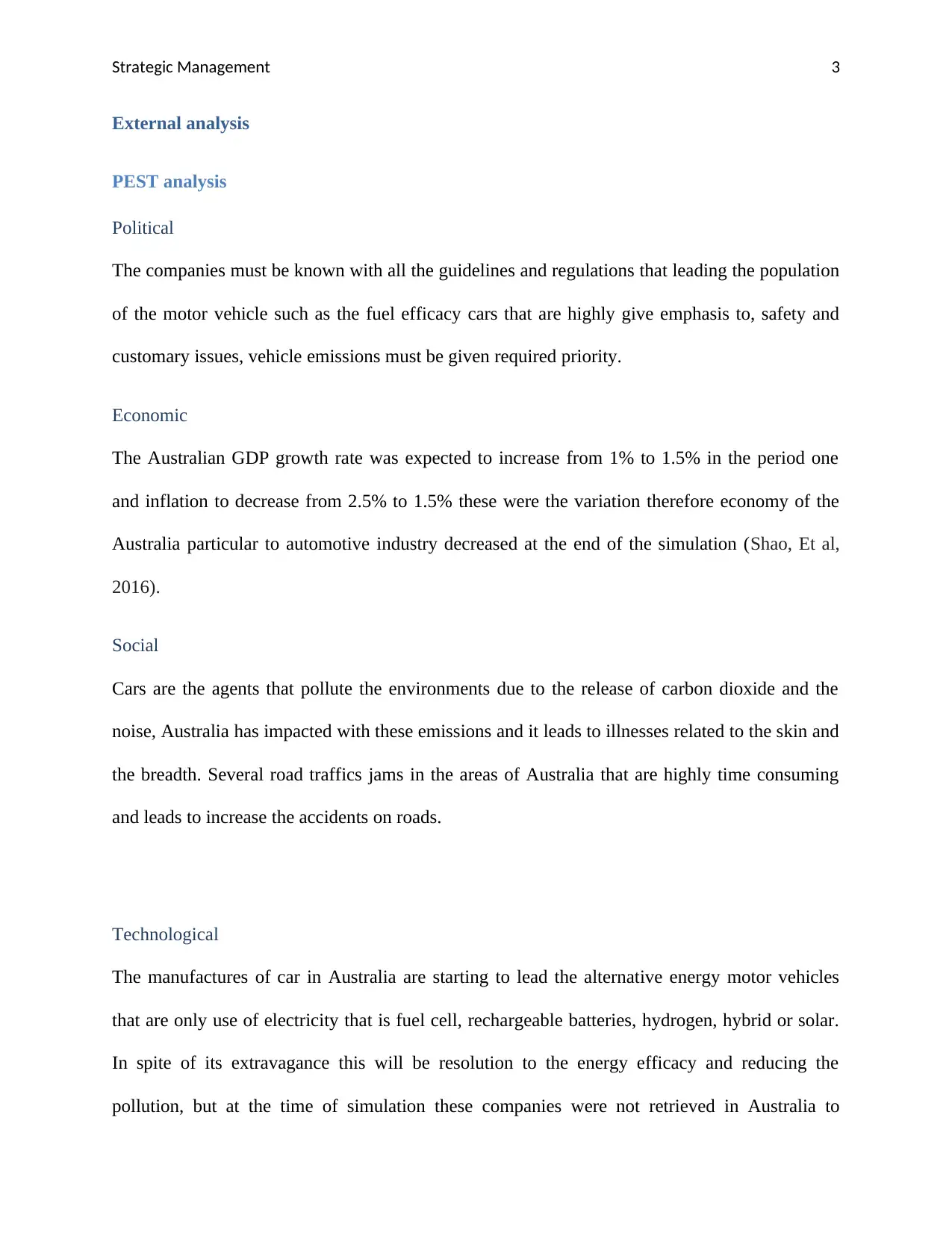
Strategic Management 3
External analysis
PEST analysis
Political
The companies must be known with all the guidelines and regulations that leading the population
of the motor vehicle such as the fuel efficacy cars that are highly give emphasis to, safety and
customary issues, vehicle emissions must be given required priority.
Economic
The Australian GDP growth rate was expected to increase from 1% to 1.5% in the period one
and inflation to decrease from 2.5% to 1.5% these were the variation therefore economy of the
Australia particular to automotive industry decreased at the end of the simulation (Shao, Et al,
2016).
Social
Cars are the agents that pollute the environments due to the release of carbon dioxide and the
noise, Australia has impacted with these emissions and it leads to illnesses related to the skin and
the breadth. Several road traffics jams in the areas of Australia that are highly time consuming
and leads to increase the accidents on roads.
Technological
The manufactures of car in Australia are starting to lead the alternative energy motor vehicles
that are only use of electricity that is fuel cell, rechargeable batteries, hydrogen, hybrid or solar.
In spite of its extravagance this will be resolution to the energy efficacy and reducing the
pollution, but at the time of simulation these companies were not retrieved in Australia to
External analysis
PEST analysis
Political
The companies must be known with all the guidelines and regulations that leading the population
of the motor vehicle such as the fuel efficacy cars that are highly give emphasis to, safety and
customary issues, vehicle emissions must be given required priority.
Economic
The Australian GDP growth rate was expected to increase from 1% to 1.5% in the period one
and inflation to decrease from 2.5% to 1.5% these were the variation therefore economy of the
Australia particular to automotive industry decreased at the end of the simulation (Shao, Et al,
2016).
Social
Cars are the agents that pollute the environments due to the release of carbon dioxide and the
noise, Australia has impacted with these emissions and it leads to illnesses related to the skin and
the breadth. Several road traffics jams in the areas of Australia that are highly time consuming
and leads to increase the accidents on roads.
Technological
The manufactures of car in Australia are starting to lead the alternative energy motor vehicles
that are only use of electricity that is fuel cell, rechargeable batteries, hydrogen, hybrid or solar.
In spite of its extravagance this will be resolution to the energy efficacy and reducing the
pollution, but at the time of simulation these companies were not retrieved in Australia to
Secure Best Marks with AI Grader
Need help grading? Try our AI Grader for instant feedback on your assignments.
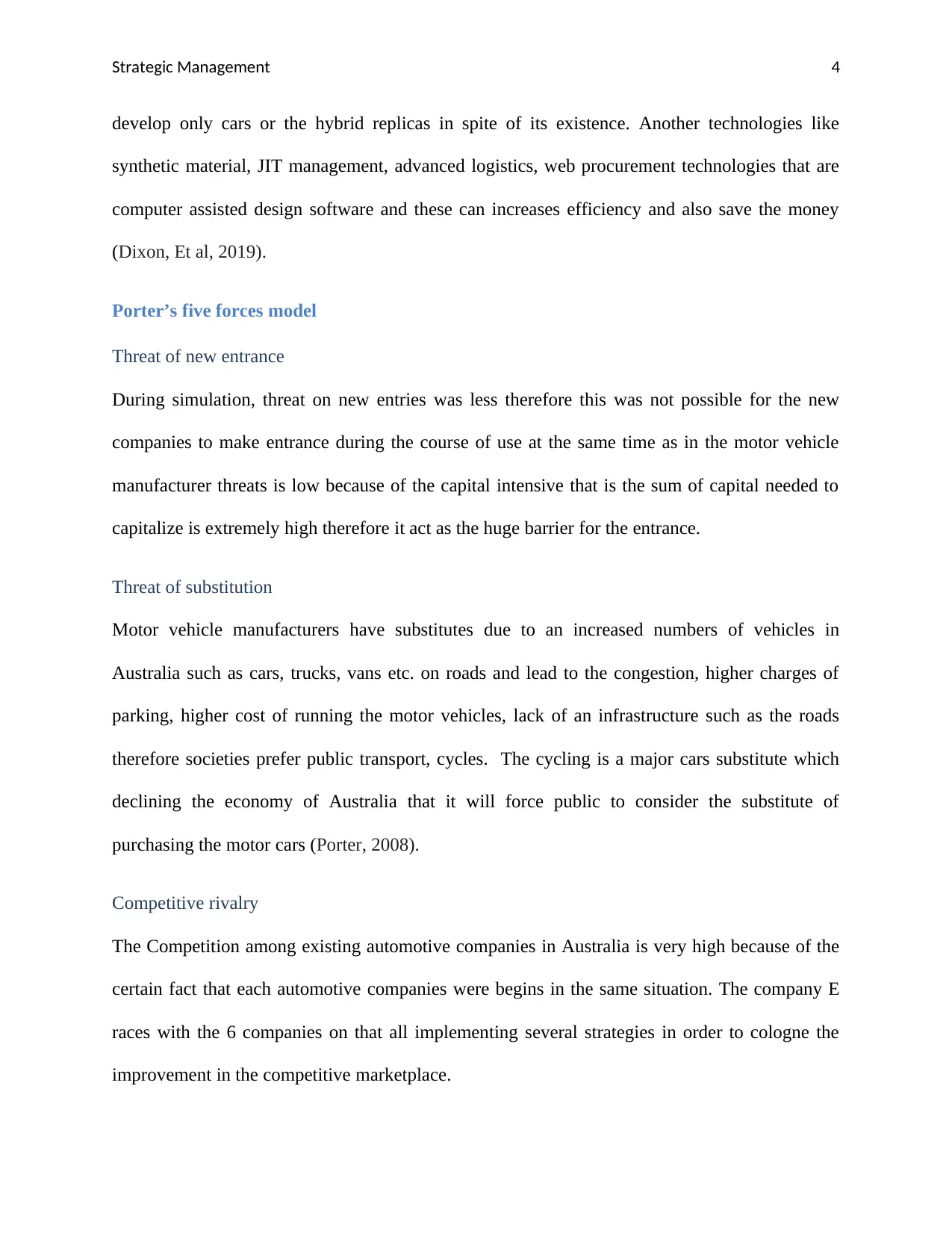
Strategic Management 4
develop only cars or the hybrid replicas in spite of its existence. Another technologies like
synthetic material, JIT management, advanced logistics, web procurement technologies that are
computer assisted design software and these can increases efficiency and also save the money
(Dixon, Et al, 2019).
Porter’s five forces model
Threat of new entrance
During simulation, threat on new entries was less therefore this was not possible for the new
companies to make entrance during the course of use at the same time as in the motor vehicle
manufacturer threats is low because of the capital intensive that is the sum of capital needed to
capitalize is extremely high therefore it act as the huge barrier for the entrance.
Threat of substitution
Motor vehicle manufacturers have substitutes due to an increased numbers of vehicles in
Australia such as cars, trucks, vans etc. on roads and lead to the congestion, higher charges of
parking, higher cost of running the motor vehicles, lack of an infrastructure such as the roads
therefore societies prefer public transport, cycles. The cycling is a major cars substitute which
declining the economy of Australia that it will force public to consider the substitute of
purchasing the motor cars (Porter, 2008).
Competitive rivalry
The Competition among existing automotive companies in Australia is very high because of the
certain fact that each automotive companies were begins in the same situation. The company E
races with the 6 companies on that all implementing several strategies in order to cologne the
improvement in the competitive marketplace.
develop only cars or the hybrid replicas in spite of its existence. Another technologies like
synthetic material, JIT management, advanced logistics, web procurement technologies that are
computer assisted design software and these can increases efficiency and also save the money
(Dixon, Et al, 2019).
Porter’s five forces model
Threat of new entrance
During simulation, threat on new entries was less therefore this was not possible for the new
companies to make entrance during the course of use at the same time as in the motor vehicle
manufacturer threats is low because of the capital intensive that is the sum of capital needed to
capitalize is extremely high therefore it act as the huge barrier for the entrance.
Threat of substitution
Motor vehicle manufacturers have substitutes due to an increased numbers of vehicles in
Australia such as cars, trucks, vans etc. on roads and lead to the congestion, higher charges of
parking, higher cost of running the motor vehicles, lack of an infrastructure such as the roads
therefore societies prefer public transport, cycles. The cycling is a major cars substitute which
declining the economy of Australia that it will force public to consider the substitute of
purchasing the motor cars (Porter, 2008).
Competitive rivalry
The Competition among existing automotive companies in Australia is very high because of the
certain fact that each automotive companies were begins in the same situation. The company E
races with the 6 companies on that all implementing several strategies in order to cologne the
improvement in the competitive marketplace.
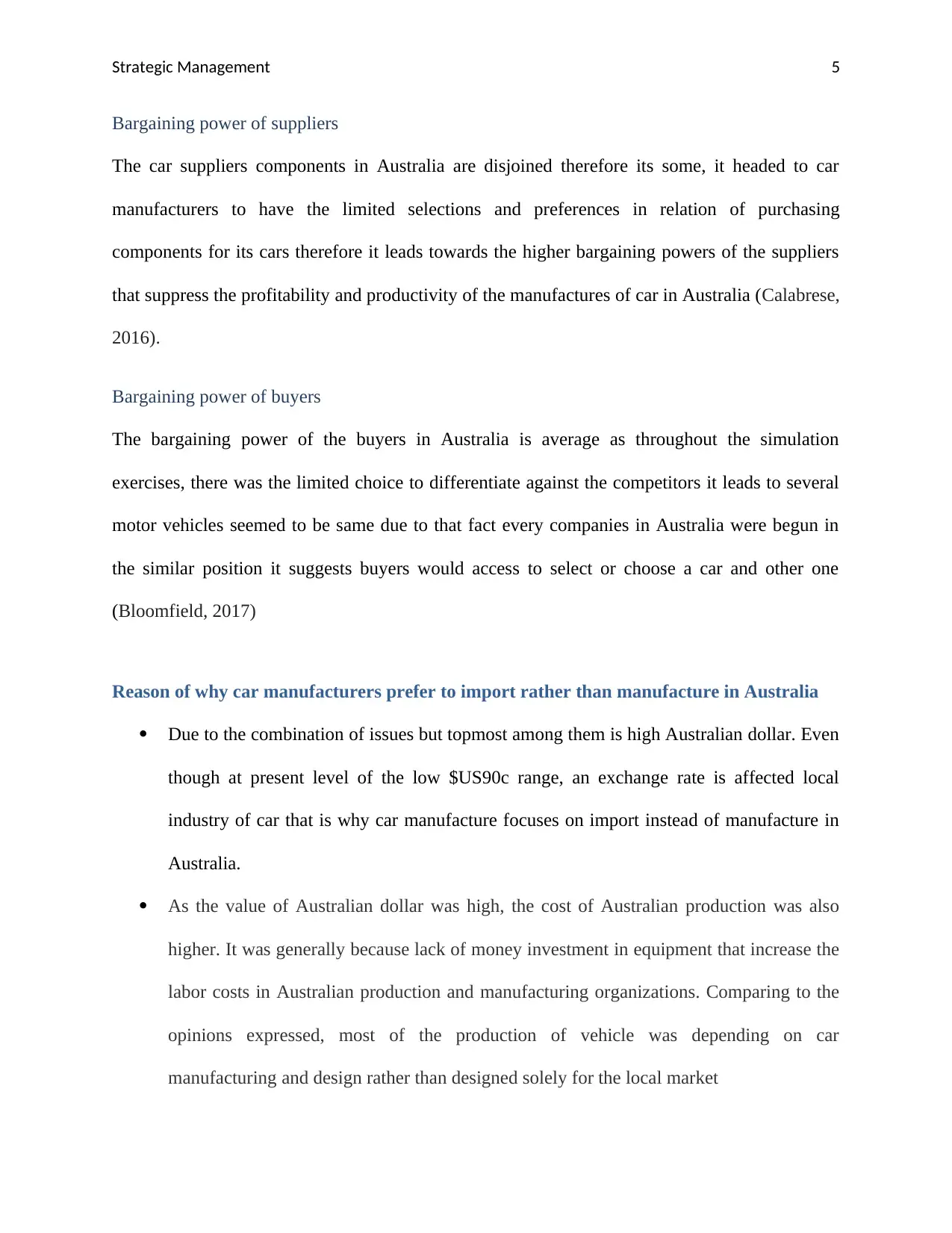
Strategic Management 5
Bargaining power of suppliers
The car suppliers components in Australia are disjoined therefore its some, it headed to car
manufacturers to have the limited selections and preferences in relation of purchasing
components for its cars therefore it leads towards the higher bargaining powers of the suppliers
that suppress the profitability and productivity of the manufactures of car in Australia (Calabrese,
2016).
Bargaining power of buyers
The bargaining power of the buyers in Australia is average as throughout the simulation
exercises, there was the limited choice to differentiate against the competitors it leads to several
motor vehicles seemed to be same due to that fact every companies in Australia were begun in
the similar position it suggests buyers would access to select or choose a car and other one
(Bloomfield, 2017)
Reason of why car manufacturers prefer to import rather than manufacture in Australia
Due to the combination of issues but topmost among them is high Australian dollar. Even
though at present level of the low $US90c range, an exchange rate is affected local
industry of car that is why car manufacture focuses on import instead of manufacture in
Australia.
As the value of Australian dollar was high, the cost of Australian production was also
higher. It was generally because lack of money investment in equipment that increase the
labor costs in Australian production and manufacturing organizations. Comparing to the
opinions expressed, most of the production of vehicle was depending on car
manufacturing and design rather than designed solely for the local market
Bargaining power of suppliers
The car suppliers components in Australia are disjoined therefore its some, it headed to car
manufacturers to have the limited selections and preferences in relation of purchasing
components for its cars therefore it leads towards the higher bargaining powers of the suppliers
that suppress the profitability and productivity of the manufactures of car in Australia (Calabrese,
2016).
Bargaining power of buyers
The bargaining power of the buyers in Australia is average as throughout the simulation
exercises, there was the limited choice to differentiate against the competitors it leads to several
motor vehicles seemed to be same due to that fact every companies in Australia were begun in
the similar position it suggests buyers would access to select or choose a car and other one
(Bloomfield, 2017)
Reason of why car manufacturers prefer to import rather than manufacture in Australia
Due to the combination of issues but topmost among them is high Australian dollar. Even
though at present level of the low $US90c range, an exchange rate is affected local
industry of car that is why car manufacture focuses on import instead of manufacture in
Australia.
As the value of Australian dollar was high, the cost of Australian production was also
higher. It was generally because lack of money investment in equipment that increase the
labor costs in Australian production and manufacturing organizations. Comparing to the
opinions expressed, most of the production of vehicle was depending on car
manufacturing and design rather than designed solely for the local market
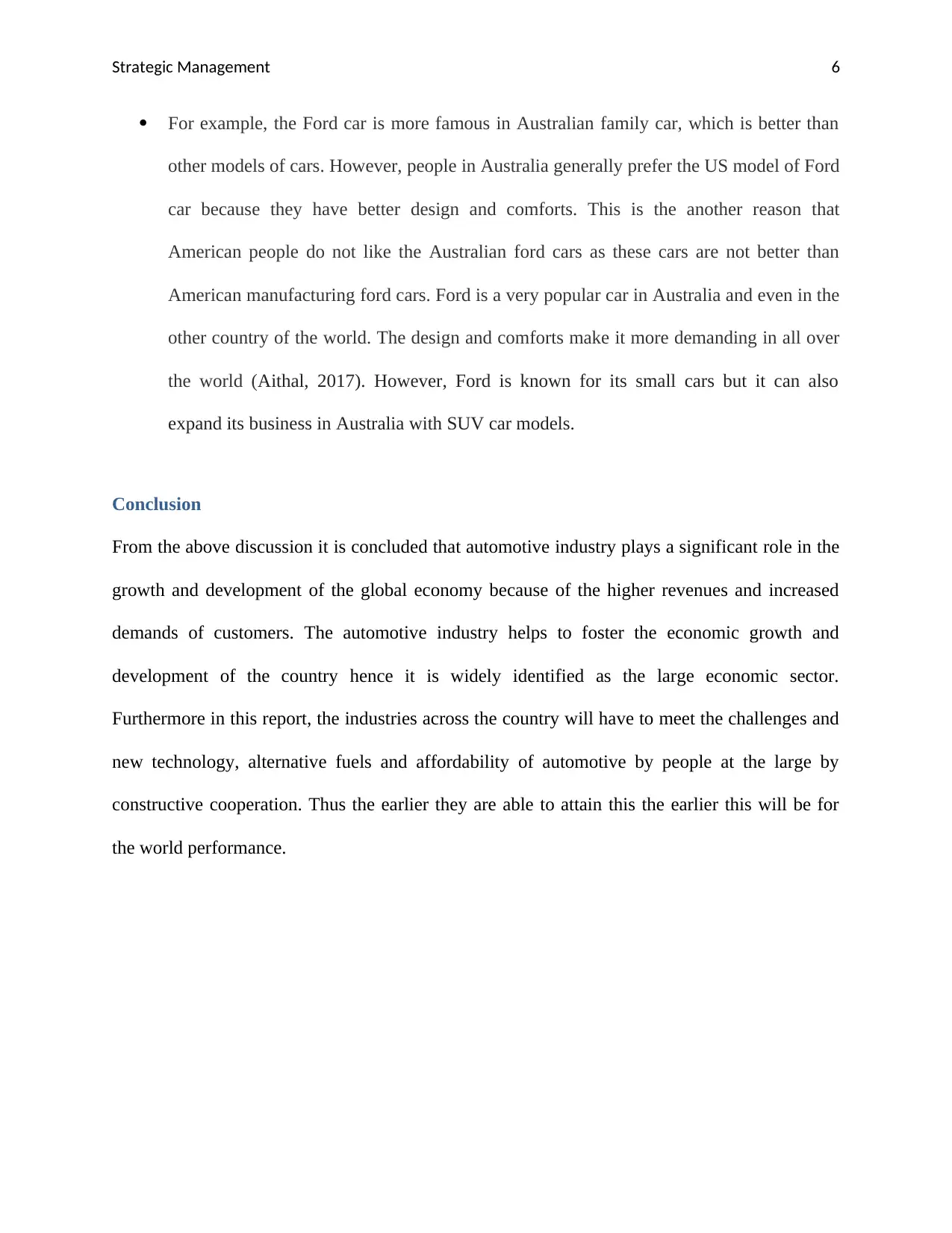
Strategic Management 6
For example, the Ford car is more famous in Australian family car, which is better than
other models of cars. However, people in Australia generally prefer the US model of Ford
car because they have better design and comforts. This is the another reason that
American people do not like the Australian ford cars as these cars are not better than
American manufacturing ford cars. Ford is a very popular car in Australia and even in the
other country of the world. The design and comforts make it more demanding in all over
the world (Aithal, 2017). However, Ford is known for its small cars but it can also
expand its business in Australia with SUV car models.
Conclusion
From the above discussion it is concluded that automotive industry plays a significant role in the
growth and development of the global economy because of the higher revenues and increased
demands of customers. The automotive industry helps to foster the economic growth and
development of the country hence it is widely identified as the large economic sector.
Furthermore in this report, the industries across the country will have to meet the challenges and
new technology, alternative fuels and affordability of automotive by people at the large by
constructive cooperation. Thus the earlier they are able to attain this the earlier this will be for
the world performance.
For example, the Ford car is more famous in Australian family car, which is better than
other models of cars. However, people in Australia generally prefer the US model of Ford
car because they have better design and comforts. This is the another reason that
American people do not like the Australian ford cars as these cars are not better than
American manufacturing ford cars. Ford is a very popular car in Australia and even in the
other country of the world. The design and comforts make it more demanding in all over
the world (Aithal, 2017). However, Ford is known for its small cars but it can also
expand its business in Australia with SUV car models.
Conclusion
From the above discussion it is concluded that automotive industry plays a significant role in the
growth and development of the global economy because of the higher revenues and increased
demands of customers. The automotive industry helps to foster the economic growth and
development of the country hence it is widely identified as the large economic sector.
Furthermore in this report, the industries across the country will have to meet the challenges and
new technology, alternative fuels and affordability of automotive by people at the large by
constructive cooperation. Thus the earlier they are able to attain this the earlier this will be for
the world performance.
Paraphrase This Document
Need a fresh take? Get an instant paraphrase of this document with our AI Paraphraser
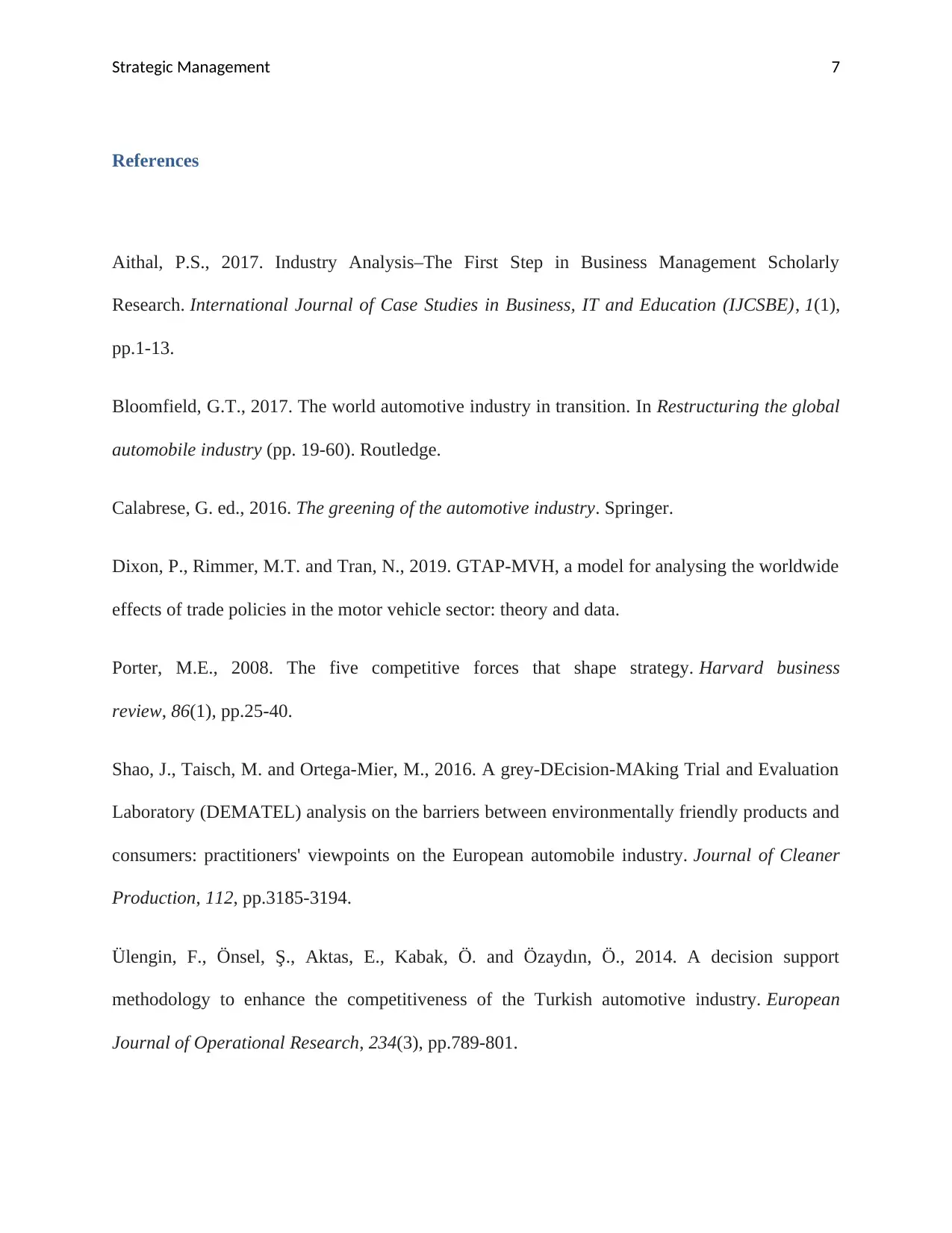
Strategic Management 7
References
Aithal, P.S., 2017. Industry Analysis–The First Step in Business Management Scholarly
Research. International Journal of Case Studies in Business, IT and Education (IJCSBE), 1(1),
pp.1-13.
Bloomfield, G.T., 2017. The world automotive industry in transition. In Restructuring the global
automobile industry (pp. 19-60). Routledge.
Calabrese, G. ed., 2016. The greening of the automotive industry. Springer.
Dixon, P., Rimmer, M.T. and Tran, N., 2019. GTAP-MVH, a model for analysing the worldwide
effects of trade policies in the motor vehicle sector: theory and data.
Porter, M.E., 2008. The five competitive forces that shape strategy. Harvard business
review, 86(1), pp.25-40.
Shao, J., Taisch, M. and Ortega-Mier, M., 2016. A grey-DEcision-MAking Trial and Evaluation
Laboratory (DEMATEL) analysis on the barriers between environmentally friendly products and
consumers: practitioners' viewpoints on the European automobile industry. Journal of Cleaner
Production, 112, pp.3185-3194.
Ülengin, F., Önsel, Ş., Aktas, E., Kabak, Ö. and Özaydın, Ö., 2014. A decision support
methodology to enhance the competitiveness of the Turkish automotive industry. European
Journal of Operational Research, 234(3), pp.789-801.
References
Aithal, P.S., 2017. Industry Analysis–The First Step in Business Management Scholarly
Research. International Journal of Case Studies in Business, IT and Education (IJCSBE), 1(1),
pp.1-13.
Bloomfield, G.T., 2017. The world automotive industry in transition. In Restructuring the global
automobile industry (pp. 19-60). Routledge.
Calabrese, G. ed., 2016. The greening of the automotive industry. Springer.
Dixon, P., Rimmer, M.T. and Tran, N., 2019. GTAP-MVH, a model for analysing the worldwide
effects of trade policies in the motor vehicle sector: theory and data.
Porter, M.E., 2008. The five competitive forces that shape strategy. Harvard business
review, 86(1), pp.25-40.
Shao, J., Taisch, M. and Ortega-Mier, M., 2016. A grey-DEcision-MAking Trial and Evaluation
Laboratory (DEMATEL) analysis on the barriers between environmentally friendly products and
consumers: practitioners' viewpoints on the European automobile industry. Journal of Cleaner
Production, 112, pp.3185-3194.
Ülengin, F., Önsel, Ş., Aktas, E., Kabak, Ö. and Özaydın, Ö., 2014. A decision support
methodology to enhance the competitiveness of the Turkish automotive industry. European
Journal of Operational Research, 234(3), pp.789-801.
1 out of 8
Related Documents
Your All-in-One AI-Powered Toolkit for Academic Success.
+13062052269
info@desklib.com
Available 24*7 on WhatsApp / Email
![[object Object]](/_next/static/media/star-bottom.7253800d.svg)
Unlock your academic potential
© 2024 | Zucol Services PVT LTD | All rights reserved.





